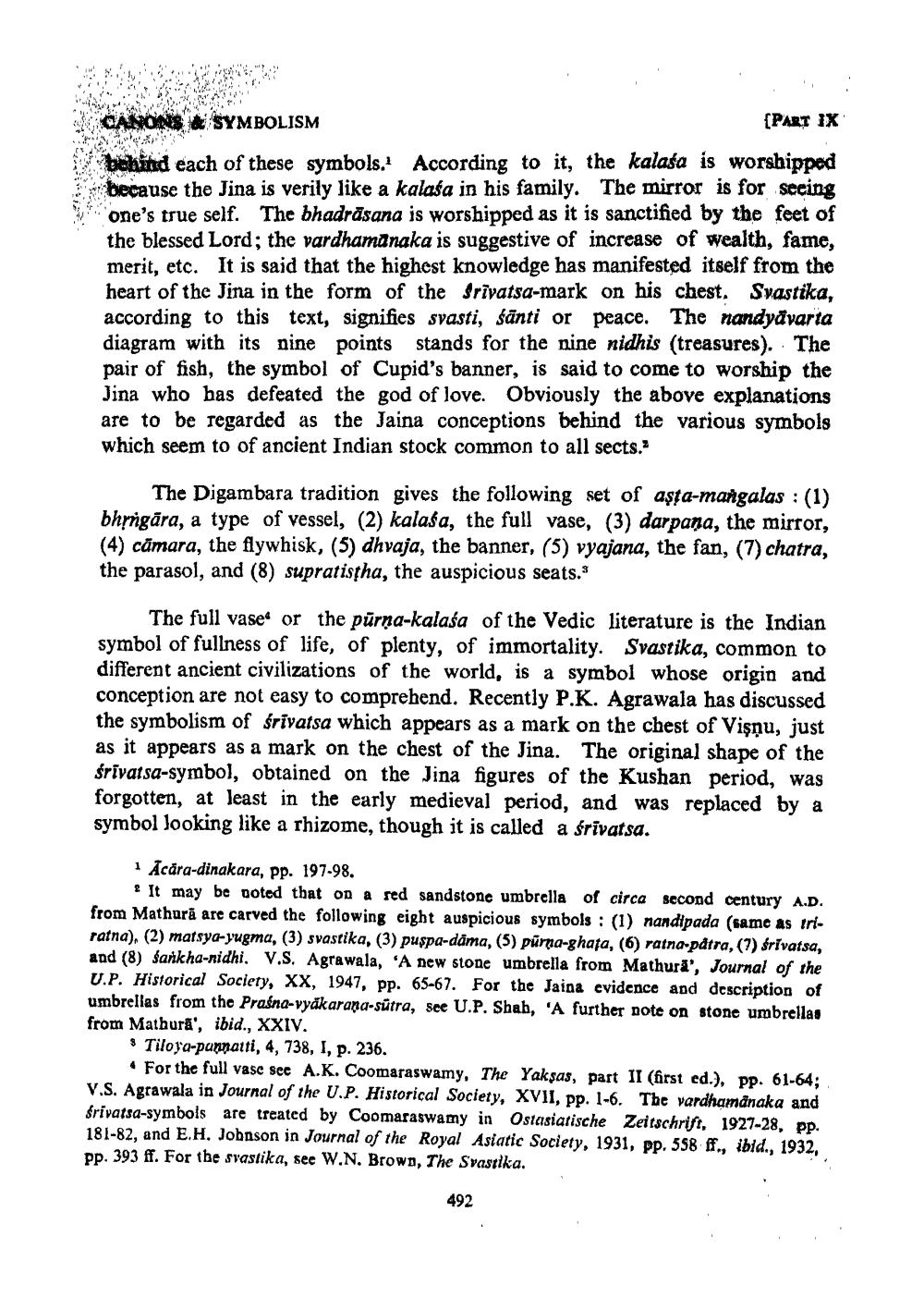________________
CANONS & SYMBOLISM
(PART IX
behind each of these symbols. According to it, the kalasa is worshipped because the Jina is verily like a kalasa in his family. The mirror is for seeing one's true self. The bhadrâsana is worshipped as it is sanctified by the feet of the blessed Lord; the vardhamanaka is suggestive of increase of wealth, fame, merit, etc. It is said that the highest knowledge has manifested itself from the heart of the Jina in the form of the Srivatsa-mark on his chest. Svastika, according to this text, signifies svasti, śānti or peace. The nandyävarta diagram with its nine points stands for the nine nidhis (treasures). The pair of fish, the symbol of Cupid's banner, is said to come to worship the Jina who has defeated the god of love. Obviously the above explanations are to be regarded as the Jaina conceptions behind the various symbols which seem to of ancient Indian stock common to all sects.
The Digambara tradition gives the following set of aşta-mangalas : (1) bhrngāra, a type of vessel, (2) kalasa, the full vase, (3) darpana, the mirror, (4) câmara, the flywhisk, (5) dhvaja, the banner, (5) vyajana, the fan, (7) chatra, the parasol, and (8) supratistha, the auspicious seats.
The full vases or the purņa-kalaśa of the Vedic literature is the Indian symbol of fullness of life, of plenty, of immortality. Svastika, common to different ancient civilizations of the world, is a symbol whose origin and conception are not easy to comprehend. Recently P.K. Agrawala has discussed the symbolism of srivatsa which appears as a mark on the chest of Vişnu, just as it appears as a mark on the chest of the Jina. The original shape of the śrīvatsa-symbol, obtained on the Jina figures of the Kushan period, was forgotten, at least in the early medieval period, and was replaced by a symbol looking like a rhizome, though it is called a srivatsa.
Acara-dinakara, pp. 197-98.
? It may be ooted that on a red sandstonc umbrella of circa second century A.D. from Mathurā are carved the following eight auspicious symbols : (1) nandipada (same as triratna), (2) matsya-yugma, (3) svastika, (3) puspa-dāma, (5) pürna-ghata, (6) ratna-pdtra, (7) srivatsa, and (8) sankha-nidhi, V.S. Agrawala, 'A new stone umbrella from Mathura', Journal of the U.P. Historical Society, XX, 1947, pp. 65-67. For the Jaina evidence and description of umbrellas from the Praśna-vyákarana-sútra, see U.P. Shah, 'A further note on stone umbrellas from Mathura', ibid., XXIV.
* Tiloya-punnarti, 4, 738, I, p. 236.
. For the full vasc sec A.K. Coomaraswamy, The Yaksas, part II (first ed.), pp. 61-64; V.S. Agrawala in Journal of the U.P. Historical Society, XVII, pp. 1-6. The vardhamanaka and frivatsa-symbols are treated by Coomaraswamy in Ostasiatische Zeitschrift, 1927-28, pp. 181-82, and E.H. Johnson in Journal of the Royal Asiatic Society, 1931, pp. 358 ff., ibid., 1932, pp. 393 ff. For the svastika, see W.N. Brown, The Svastika.
492




